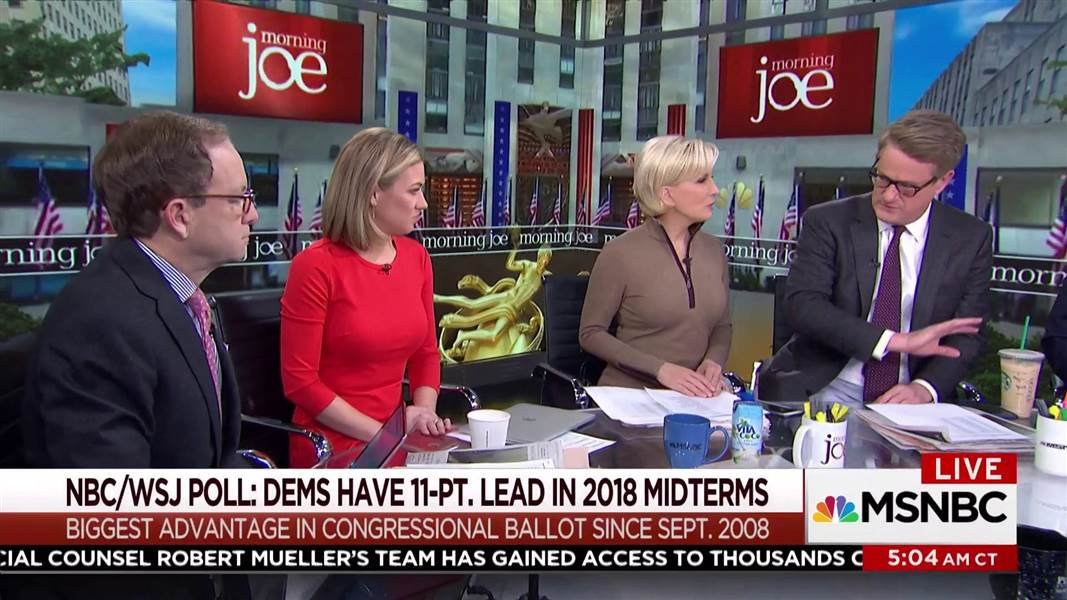WASHINGTON — In every midterm election since the Civil War, the president’s party has lost, on average, 32 seats in the House and two in the Senate.
In next year’s battles, Democrats need only 24 seats to flip the House and two to take the Senate.
“History says we’re going to lose the majority,” said Cory Bliss, the executive director of the Congressional Leadership Fund, a major Republican super PAC. “Our job is defy history.”
Rarely has a president alienated so many Americans so quickly as Donald Trump. And after nearly a year of total GOP control in Washington, voters say by double digits they’d rather have the Democrats in charge on Capitol Hill.
“There’s a lot of buyer’s remorse out here,” said Tim Waters, the political director of the Pittsburgh-based United Steelworkers union. “People have gone out of their way to give these guys a chance, and it just hasn’t paid off.”
But the GOP majorities are defended not just by incumbency and super PACs, but by structural advantages in both chambers.
“We remain in prime position to defend our majorities in 2018,” said Republican National Chairman Ronna McDaniels, in a statement to NBC News.
In the Senate, the battleground offers far more liabilities than opportunities for Democrats because the 33 states in play next year are redder than average.
“We’re going to have a headwind, there’s no question about that,” said Rob Jesmer, the former executive director of the National Republican Senatorial Committee. “The question is, does the map bail us out?”
And in the House, Democrats will need to win the popular vote by an especially wide margin to overcome GOP gerrymandering and Democrats’ own natural geographic handicap. That basically means Democrats can’t take the chamber without a landslide.
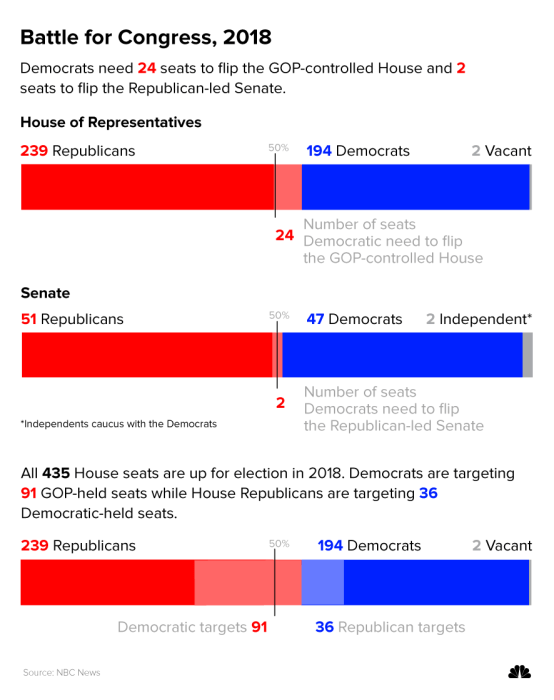
For instance, in 2012, House Democrats won about 1 million more votes nationwide than Republicans, but that wasn’t big enough to put them anywhere near retaking the chamber.
Experts disagree on exactly how big of a landslide Democrats need in the House — estimates range from as little as 53 percent to as much as 58 percent of the national vote — but they agree a narrow majority like 2012’s won’t cut it.
Meanwhile, Republican voters are typically more reliable than Democrats in non-presidential elections, making it less likely to see the kind of collapse Barack Obama suffered during his two midterm elections in 2010, when his party lost the majority in the House, and in 2014, when they lost the Senate.
“The problem is Trump is still very popular within in the Republican Party, like it or not,” said Rep. Tim Ryan, D-Ohio. “It’s hard to have a wave if the intensity with the incumbent is high.”
Things can and will change. An unexpected and quickly forgotten Ebola scare, and dissatisfaction with the Obama administration’s handling of the crisis, dominated the final weeks of the 2014 midterms and gave a boost to Republicans.
The Senate
What to watch:
- Anti-establishment vs. establishment GOP primaries
- Democrats on defense in states Trump won: Indiana, West Virginia, Montana, North Dakota, Florida, Ohio, Wisconsin, Michigan, Pennsylvania
- Minnesota (Tina Smith, who will be the successor to Sen. Al Franken, D-Minn., will be running to fill his term)
- Democrats on offense: Nevada, Arizona
- Will unexpected states get competitive? Democrats are keeping an eye on Tennessee and Texas
Two countervailing forces — Democratic energy and a GOP dream map — are expected to largely cancel each other out this year and leave the GOP majority intact. But with Republicans defending a thin majority, down to just two seats after Doug Jones’ surprise win in Alabama, even small changes could reset the chamber.

“The political structure of some of these states will allow us to save a majority in what will be a very difficult year,” said Jesmer, the former top GOP Senate operative.
Only a third of the Senate’s 100 seats are up for grabs in any one election, and with this set, Republicans lucked out.
Democrats have to defend 10 seats in states Trump won, including in five where he won by double digits and where he remains popular. That leaves them with just two solid pickup opportunities — in Nevada and Arizona.

Nonetheless, there are still a few wildcards that could shake up the stalemate.
Republicans in several key states, including Nevada and Arizona, are locked in divisive primary battles egged on by activists like former Trump adviser Steve Bannon, which could produce flawed or far-right nominees.
“If we nominate fringe candidates who show they aren’t ready to govern, we’re going to sacrifice seats,” said Alex Conant, a former adviser to Sen. Marco Rubio, R-Fla.
Senate Democrats have become adept at quietly sidelining candidates they think are unelectable and clearing the way for favored ones.
Meanwhile, two senators are facing serious health issues, including one, John McCain, R-Ariz., from a competitive state, and another, Thad Cochran, R-Miss., whose vacancy would trigger a potentially nasty GOP primary.
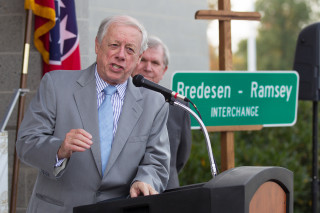
Democrats are also hoping to expand the map and get lucky with more strong candidates like former Tennessee Gov. Phil Bredesen, who thrilled his party by jumping into the race for an open Senate seat.
“The lesson from Alabama is, if you field the right candidate and the environment is right, that nothing is in the realm of the impossible,” said Lynda Tran, a founding partner of the Obama-aligned 270 Strategies.
The House of Representatives
What to watch:
- The suburban revolt against Republicans
- Democratic primaries
- Republican retirements
- The magic number for Democrats: 24
With control of the chamber — and the potential impeachment of the president that could come with it — on the line, the House will upstage its big brother in the Senate this time around.
There are so many rosy data points for House Democrats it’s hard to know where to begin. Democratic challengers are out-fundraising, out-polling and out-recruiting both their own records and their GOP incumbents, 32 of whom have already decided to retire rather than run for re-election (compared to 16 Democrats).
Polling, wrote analyst Harry Enten of FiveThirtyEight, shows “Republicans in worse shape right now than any other majority party at this point in the midterm cycle since at least the 1938 election.”
Preparing for a wave, Democrats are putting as many proverbial surfboards as possible in the water, targeting 91 congressional districts (compared to 36 for Republicans).
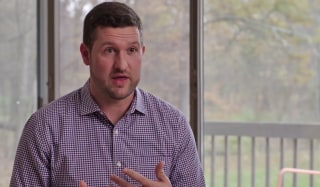
“The Democratic enthusiasm here is unprecedented. I’ve never seen anything like it,” said Pat Ryan, who is running against a Republican incumbent in an upstate New York district that swung from Obama to Trump.
Ryan, a West Point graduate who did two tours in Iraq before starting a small IT business, is indicative of the bumper crop of quality candidates Democrats have managed to recruit this year.
“You are seeing credible candidates in races that we’ve never been competitive in before,” said Charlie Kelly, the executive director of House Majority PAC, Democrats’ primary House super PAC.
To defend their majority, Republicans are reaching for a familiar playbook.
“We’re going to put Nancy Pelosi on trial and prosecute the case,” said Bliss, the GOP super PAC boss whose groups plan to spend over $100 million this cycle. “Every morning at CLF (Congressional Leadership Fund), we take a moment of silence to appreciate Nancy Pelosi and thank her. We hope she never retires.”

Such attacks worked against Jon Ossoff in Georgia’s special congressional election this year, but they may also be Republicans’ only card to play.
Republicans’ don’t dispute that there’s an enthusiasm gap, but they see a silver lining in the competitive and potentially damaging Democratic primaries across the country.
Jim Hagedorn, a Republican running in a Democratic-held Minnesota district considered one of the GOP’s best pickup opportunities, has watched happily as he says the seven candidates vying to be his Democratic opponent trip over themselves to adopt “goofy left” positions on guns and abortion, among other issues.
“The people are not so much in favor of what the Democrat party has transformed into in the past 30 years,” Hagedorn said. “It no longer stands for farmers. It no longer stands for union members. They’ve become very left-wing.”
Democrats are likely to make gains in the kinds of educated and affluent suburbs that seem turned off by Trump’s brand of Republican politics. Places like Orange County, California, suburban Chicago and northern Virginia are fertile ground for Democrats.
But to get the majority, they also need to win back traditionally Democratic districts of working-class whites in the Midwest and Rust Belt, where Republicans believe they can make gains.
Governors, State Legislatures
What to watch:
- Run-up to redistricting
- Primaries in both parties
While often overlooked, these races will determine who gets to control the map in the upcoming redistricting process after the 2020 Census for both Congress and state legislatures.
“Redistricting is as important as any presidential election,” said Waters of the United Steelworkers, which was heavily involved in Alabama.
The Obama era was dreadful for Democrats in state capitals, leaving them with just 16 out of 50 governorships and down nearly 1,000 fewer state legislative seats. Republicans used the gains from the 2010 wave to set up a decade of policy victories, supported by favorable new maps in key swing states.
But that failure now begets opportunity as the Democrats have a chance to win back territory in friendly states like New Mexico, Illinois, Maryland and Maine.
“Democrats have nowhere to go but up,” said Jennifer Duffy, who tracks governor races for the non-partisan Cook Political Report. “Republicans have nowhere to go but down. And their job here is to minimize their losses.”
But Democrats will first have to get through a number of potentially painful primaries everywhere from Georgia to Maryland to Ohio to Minnesota and more, which will test the party’s fissures on race, gender and ideology.
“These Democratic primaries to me are the showcases of the divisions in the Democratic Party. You’ve got a lot of candidates trying to be the most progressive,” said Duffy.
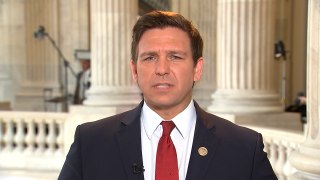
Republicans have to mind their own primaries, too, as the wave of governors elected in 2010 starts to be forced out by term limits. In Florida, for instance, Trump made a surprise endorsement of conservative Rep. Ron DeSantis, R-Fla., instead of supporting front-runner Adam Putnam, who is favored by many Florida Republicans.
The range of possible outcomes is as wide as the map — 36 states will elect governors in 2018 — and Democrats are feeling bullish enough to compete in most of them, including in Southern states like Georgia, South Carolina and Oklahoma.
“We definitely are in a position to do well in Tennessee in 2018,” said Karl Dean, the former mayor of Nashville, who is now running as a moderate Democrat for the state’s top job.
Meanwhile, Democrats are just 13 seats away from flipping seven closely divided state legislative chambers in November.
Democrats already grabbed 33 GOP seats in 2017. And in dozens of under-the-radar state legislative races, Democrats on average performed about 13 percentage points better than Hillary Clinton did in 2016 and 10 points better than Obama did in 2012, according to an analysis by Daily Kos, the liberal website.
If they can maintain those advantages through 2018, it could be enough to make gains in surprising places.
Still, it will be tough for the party to make inroads in places they have ignored in recent years. In Georgia, for instance, Clinton won multiple state legislative districts where Democrats didn’t even have a candidate.
Bob Trammell, the new minority leader of the Georgia State House, said he’s thrilled by the quality of Democratic candidates and energy he’s seeing, but under no illusions about the difficulty of the task ahead in getting people who are used to voting Republican to consider switching sides.
“It takes a lot to get people to switch to Coke,” he said, “if Pepsi is what they’ve been drinking their whole life.”
*News Searching By NBC*

